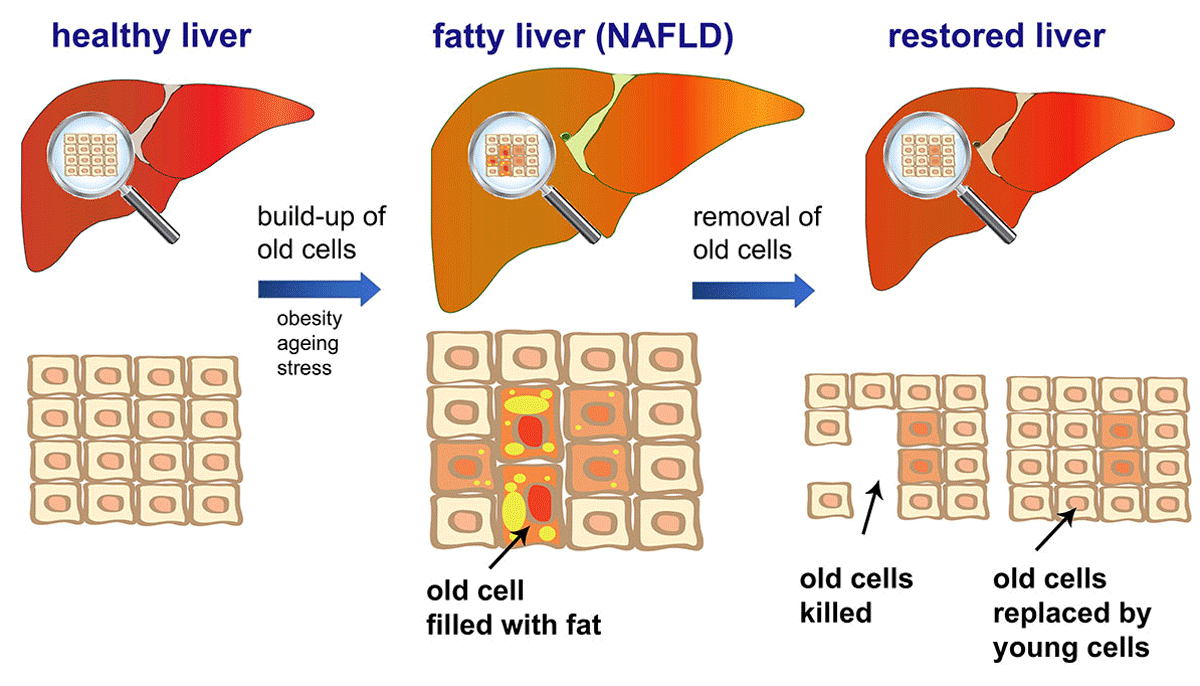Fatty liver disease reversed
Scientists reverse mechanism of fatty liver disease
Published on: 13 June 2017
Researchers have identified the mechanism which causes a build-up of fat in the liver in a disease affecting one in five in the UK – and were able to reverse it in a mouse model.
People with Non-Alcoholic Fatty Liver Disease (NAFLD) develop excess fat in the liver even though they drink little or no alcohol. The condition can range from simple fatty liver to fibrosis and cirrhosis, and can ultimately lead to liver cancer.
A group of international researchers publishing today in the journal Nature Communications, report that senescent or old cells in the liver store excessive fat because mitochondria, the batteries of the cells, become damaged and cannot effectively use the fat as a source of fuel, resulting in its storage.

Reversing the process
Researchers from the Newcastle University Institute for Ageing, in collaboration with researchers from the Mayo Clinic, USA, and the Erasmus Medical Centre, in The Netherlands, used pharmacological and genetic approaches to “kill-off” senescent cells from mice, to decrease the build-up of unwanted fat in the liver and restore liver function to normal.
Dr Diana Jurk from Newcastle University’s Institute for Ageing who leads the research team, said: “As we age we accumulate cell damage and we have shown that these older cells are storing excess fat due to their inefficient mitochondria. What is exciting is that we have been able to reverse this damage in mice by removing these older, worn-out cells, which opens the door to a potential cure."
Method
The team used two separate methods to eliminate senescent cells; firstly by using a genetically engineered mouse in which senescent, worn-out cells can be “killed-off” and secondly by a treatment with a combination of the drugs - dasatinib and quercetin (D+Q) – known to specifically kill senescent cells. Both approaches were equally successful in reducing the build-up of fat in the liver caused by a high fat diet or ageing in mice.
Mikolaj Ogrodnik, PhD student within the Institute for Ageing and lead author on the paper said: “We are witnessing a very exciting time in ageing research. Scientists have realised that senescent cells are the cause of many diseases and we now have a way to fight them off.”
The work has been funded by the BBSRC and Newcastle University's Institute for Ageing.
The team are now intending to further their research by examining how the technique can be developed as a potential clinical treatment.
NAFLD at a glance
- Non-Alcoholic Fatty Liver Disease is caused by a build-up of fat in the liver cells
- NAFLD develops in four main stages:
- simple fatty liver (steatosis) – a largely harmless build-up of fat in the liver cells that may only be diagnosed during tests carried out for another reason
- non-alcoholic steatohepatitis (NASH) – a more serious form of NAFLD, where the liver has become inflamed; this is estimated to affect up to 5% of the UK population
- fibrosis – where persistent inflammation causes scar tissue around the liver and nearby blood vessels, but the liver is still able to function normally
- cirrhosis – the most severe stage, occurring after years of inflammation, where the liver shrinks and becomes scarred and lumpy; this damage is permanent and can lead to liver failure (where your liver stops working properly) and liver cancer
- There aren't usually any symptoms of NAFLD in the early stages. You probably won't know you have it unless it's diagnosed during tests carried out for another reason.
- Occasionally, people with NASH or fibrosis may experience: a dull or aching pain in the top right of the tummy (over the lower right side of the ribs), fatigue (extreme tiredness), unexplained weight loss, weakness
Modified 15/6/2017



